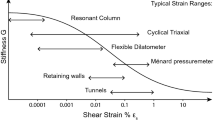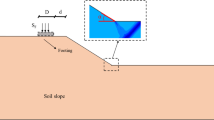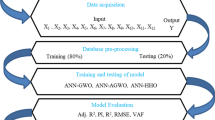Abstract
The use of artificial neural networks for parameter sensitivity analysis in civil engineering systems is an emerging research focus of increased interest. Existing methods are generally based on a single neural network, but are inadequate as a basis for parameter sensitivity analysis because of the instability of a single neural network. To address this deficiency, this study develops a neural network ensemble-based parameter sensitivity analysis paradigm. This paradigm features use of a set of preselected superior neural networks to make decisions about parameter sensitivity by synthesizing sensitivity analysis results of individual neural networks. The proposed paradigm is employed to address two classic civil engineering problems: (1) identification of critical parameters in the fracture failure of notched concrete beams and (2) recognition of the most significant parameters in the lateral deformation of deep foundation pits. The results show that tensile strength and modulus of elasticity are the critical parameters in the fracture failure of the notched concrete beam, and elasticity modulus of soil, Poisson’s ratio and soil cohesion are the most significant influential factors in the lateral deformation of the deep foundation pit. The proposed method provides a common paradigm for analysing the sensitivity of influential parameters, shedding light on the underlying mechanisms of civil engineering systems.




Similar content being viewed by others
References
Goh AT (1994) Some civil engineering applications of neural networks. Proc ICE-Struct Build 104(4):463–469
Sakellariou MG, Ferentinou MD (2005) A study of slope stability prediction using neural networks. Geotech Geolog Eng 23(4):419–445
Flood I, Kartam N (1994) Neural networks in civil engineering. II: systems and application. J Comput Civ Eng 8(2):149–162
Jeng DS, Lee TL, Lin C (2003) Application of artificial neural networks in assessment of Chi-Chi earthquake-induced liquefaction. Asian J Inf Technol 2(3):190–198
Cladera A, Mari AR (2004) Shear design procedure for reinforced normal and high-strength concrete beams using artificial neural networks. Part II: beams with stirrups. Eng Struct 26(7):927–936
Cao MS, Qiao PZ, Ren QW (2009) Improved hybrid wavelet neural network methodology for time-varying behavior prediction of engineering structures. Neural Comput Appl 18(7):821–832
Specht DF (1991) A general regression neural network. IEEE Trans Neural Netw 2(6):568–576
Olden JD, Jackson DA (2002) Illuminating the “black box”: a randomization approach for understanding variable contributions in artificial neural networks. Ecol Model 154(1):135–150
Das SK, Biswal RK, Sivakugan N, Das B (2011) Classification of slopes and prediction of factor of safety using differential evolution neural networks. Environ Earth Sci 64(1):201–210
Hadzima-Nyarko M, Nyarko EK, Morić D (2011) A neural network based modelling and sensitivity analysis of damage ratio coefficient. Expert Syst Appl 38(10):13405–13413
Jain A, Jha SK, Misra S (2008) Modeling and analysis of concrete slump using artificial neural networks. J Mater Civ Eng 20(9):628–633
Hao J, Wang B (2014) Parameter sensitivity analysis on deformation of composite soil-nailed wall using artificial neural networks and orthogonal experiment. Math Prob Eng. doi:10.1155/2014/502362
Sudheer KP (2005) Knowledge extraction from trained neural network river flow models. J Hydrol Eng 10(4):264–269
Maier HR, Dandy GC (2000) Neural networks for the prediction and forecasting of water resources variables: a review of modelling issues and applications. Environ Model Softw 15(1):101–124
Benaouda D, Wadge G, Whitmarsh RB, Rothwell RG, MacLeod C (1999) Inferring the lithology of borehole rocks by applying neural network classifiers to downhole logs: an example from the Ocean Drilling Program. Geophys J Int 136(2):477–491
Atiya A, Ji C (1997) How initial conditions affect generalization performance in large networks. IEEE Trans Neural Netw 8(2):448–451
Thimm G, Fiesler E (1997) High-order and multilayer perceptron initialization. IEEE Trans Neural Netw 8(2):349–359
Sollich P, Krogh A (1996) Learning with ensembles: how over-fitting can be useful. In: Proceedings of the 1995 conference, vol 8, pp 190–196
Cao M, Qiao P (2008) Neural network committee-based sensitivity analysis strategy for geotechnical engineering problems. Neural Comput Appl 17(5–6):509–519
Gevrey M, Dimopoulos I, Lek S (2003) Review and comparison of methods to study the contribution of variables in artificial neural network models. Ecol Model 160(3):249–264
Wang W, Jones P, Partridge D (2000) Assessing the impact of input features in a feedforward neural network. Neural Comput Appl 9(2):101–112
Bai R, Jia H, Cao P (2011) Factor sensitivity analysis with neural network simulation based on perturbation system. J Comput 6(7):1402–1407
Novák D, Teplý B, Shiraishi N (1993) Sensitivity analysis of structures: a review. In: Proceedings of CIVIL COMP, vol 93, pp 201–207
Shahin MA, Jaksa MB, Maier HR (2009) Recent advances and future challenges for artificial neural systems in geotechnical engineering applications. Adv Artif Neural Syst. doi:10.1155/2009/308239
He S, Li J (2009) Modeling nonlinear elastic behavior of reinforced soil using artificial neural networks. Appl Soft Comput 9(3):954–961
Papatheocharous E, Papadopoulos H, Andreou AS (2012) Feature subset selection for software cost modelling and estimation. arXiv preprint. arXiv:1210.1161
Raghavendra BK, Srivatsa SK (2011) Evaluation of logistic regression and neural network model with sensitivity analysis on medical datasets. Int J Comput Sci Secur (IJCSS) 5(5):503–511
De Oña J, Garrido C (2014) Extracting the contribution of independent variables in neural network models: a new approach to handle instability. Neural Comput Appl 25(3–4):859–869
Aires F, Prigent C, Rossow WB (2004) Neural network uncertainty assessment using Bayesian statistics: a remote sensing application. Neural Comput 16(11):2415–2458
Cherkassky V, Krasnopolsky V, Solomatine DP, Valdes J (2006) Computational intelligence in earth sciences and environmental applications: issues and challenges. Neural Netw 19(2):113–121
Kingston GB, Maier HR, Lambert MF (2006) A probabilistic method for assisting knowledge extraction from artificial neural networks used for hydrological prediction. Math Comput Model 44(5):499–512
Das SK, Basudhar PK (2006) Undrained lateral load capacity of piles in clay using artificial neural network. Comput Geotech 33(8):454–459
Das SK, Basudhar PK (2008) Prediction of residual friction angle of clays using artificial neural network. Eng Geol 100(3):142–145
Muduli PK, Das MR, Samui P, Kumar Das S (2013) Uplift capacity of suction caisson in clay using artificial intelligence techniques. Mar Georesour Geotechnol 31(4):375–390
Dimopoulos Y, Bourret P, Lek S (1995) Use of some sensitivity criteria for choosing networks with good generalization ability. Neural Process Lett 2(6):1–4
Garson GD (1991) Interpreting neural-network connection weights. Artif Intell Expert 6(4):46–51
Rots J G (1988) Computational modeling of concrete fracture [D]. Technische Hogeschool Delft
Carpinteri A, Ferro G (1994) Size effects on tensile fracture properties: a unified explanation based on disorder and fractality of concrete microstructure. Mater Struct 27(10):563–571
Novák D, Lehký D (2006) ANN inverse analysis based on stochastic small-sample training set simulation. Eng Appl Artif Intell 19(7):731–740
Lehký D, Keršner Z, Novák D (2014) FraMePID-3PB software for material parameter identification using fracture tests and inverse analysis. Adv Eng Softw 72:147–154
Stein M (1987) Large sample properties of simulations using Latin hypercube sampling. Technometrics 29(2):143–151
Novák D, Vořechovský M, Teplý B (2014) FReET: software for the statistical and reliability analysis of engineering problems and FReET-D: degradation module. Adv Eng Softw 72:179–192
Vořechovský M, Novák D (2009) Correlation control in small-sample Monte Carlo type simulations I: a simulated annealing approach. Probab Eng Mech 24(3):452–462
Červenka V, Jendele L, Červenka J (2009) ATENA® Program Documentation, part 1: theory, Prague, Czech Republic, May
Feng S, Wu Y, Li J, Li P, Zhang Z, Wang D (2012) The analysis of spatial effect of deep foundation pit in soft soil areas. Proc Earth Planet Sci 5:309–313
Xu C, Ye GB (2004) Parameter sensitivity analysis of numerical model by cross test design technique. Hydrogeol Eng Geol 1:95–97
Acknowledgments
This study was partially supported by the Key Program of National Natural Science Foundation of China (Grant No. 11132003), and the Projects (Grant No. LH14334 and Grant No. LO1408) under the National Sustainability Programme I, granted by the Ministry of Education of the Czech Republic.
Author information
Authors and Affiliations
Corresponding author
Rights and permissions
About this article
Cite this article
Cao, M.S., Pan, L.X., Gao, Y.F. et al. Neural network ensemble-based parameter sensitivity analysis in civil engineering systems. Neural Comput & Applic 28, 1583–1590 (2017). https://doi.org/10.1007/s00521-015-2132-4
Received:
Accepted:
Published:
Issue Date:
DOI: https://doi.org/10.1007/s00521-015-2132-4




